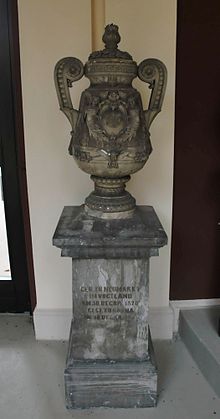Gotha main cemetery
The main cemetery in Gotha (formerly also Friedhof V ) is the largest of the six Gotha cemeteries still in existence . It is located on Langensalzaer Straße in the northeast of the Thuringian city. The crematorium from 1878 located here is the oldest in Germany.
Area
After extensions in 1908 and 1920, the cemetery now covers an area of 18.35 hectares. The cemetery has an almost rectangular shape, the long sides of which run along Heutalsweg and Pfullendorfer Straße from NNW to SSE and the short sides of which are bordered in the north by Müllersweg and in the south by a building yard belonging to Stadtwerke Gotha. The main entrance used to be here. Through it you could see from Gotha through the gate of the waiting hall to the crematorium.
The area is divided into three parts: While parts I and III to the north and south are characterized by square and rectangular areas that are separated by straight paths, the middle part is designed in the Art Nouveau style, like a park: It has beautifully looped paths based on the pattern of the larger one Hamburg-Olsdorfer Friedhofes .
Crematorium and columbarium
The crematorium, built in 1878, consists of a 50 meter long column structure made of Seeberg sandstone in neoclassical style. The elongated main building has two temple-like boundary structures connected by a colonnade, which are crowned by triangular gables. These temples are accessible via a few steps and a vestibule open in three round arches. In the western temple is the mortuary chamber, in the eastern one the crematorium and the funeral chapel. The chimney of the crematorium is built behind in the courtyard area.
The columbarium , which was added in 1892, is a glass-roofed pillar hall on a U-shaped floor plan on the colonnade wall between the two temples. It houses the urns of numerous important personalities. Centrally on a pillar is the urn of the pacifist, writer and first Nobel Peace Prize winner Bertha von Suttner , who had ordered in her will to be cremated in Gotha.
history
The old cemeteries I to IV in the north-west of the city were closed in 1874 (cemetery I), 1883 (cemetery II) and 1892 (cemeteries III and IV). In 1878 the main cemetery was laid out as Cemetery V in the north. At that time it was far from the city, at the end of Langensalzaer Strasse.
Construction and operation of the crematorium
In May 1874, under the chairmanship of Gotha District Administrator Wilhelm Ewald, the Gotha Cremation Association was founded, which intended to build a modern crematorium on the planned new cemetery. The city administration, the state ministry and the liberal-minded Duke Ernst II of Saxe-Coburg and Gotha met with goodwill, but the estimated cost of 15,000 marks for the construction was mainly due to donations from the cremation association, the first German cremation congress (1876 in Dresden ) and other private donations. A Gotha woman donated 6,000 marks anonymously, combined with the wish that a commemorative plaque should be placed in the urn hall with the inscription “Elfriede's blessing”.
In the spring of 1878, construction began on the building, designed by city planner Julius Bertuch in the neoclassic style. The technical system for cremation was designed by the engineer Karl Heinrich Stier (* December 20, 1820 in Neumark in Vogtland ; † December 10, 1877 in Gotha). The gas-powered furnace was developed in the Friedrich Siemens glassworks in Dresden. When the building was completed in November 1878, Gotha had the first crematorium in Germany and the second in Europe (the first European crematorium had already started operating in 1876 on the Cimitero Monumentale in Milan).
On December 10, 1878, Karl Heinrich Stier, who had designed the crematorium but died before it was built, was cremated in Gotha. It was the first cremation of a German in modern times and the second cremation in a cremation furnace on German territory. ( A woman from England was cremated at the first cremation in Germany , which took place on October 9, 1874, in what was then the Siemens glassworks in Dresden.) Karl Heinrich Stier had decreed in his will that his body be in a hermetically sealed metal coffin was to be temporarily buried in cemetery IV in order to be the first corpse in Germany to be surrendered to the flames after the crematorium was completed. He was the only one cremated in the opening year and the only person in Gotha who received both an earth and a cremation.
17 cremations took place in 1879. In the years that followed, more and more dead were brought to the Gotha crematorium from all over Germany. By December 10, 1882, 100 burnings had been made. Up to that point, 70 of the dead were Protestant, twelve were Catholic and five were of Jewish denomination, and for a further 13 denominations were missing.
The urns were originally set up on the colonnade wall between the temple-like structures surrounding the crematorium. When in 1892 there was no longer enough space for the urns, Julius Bertuch added the columbarium in the middle section.
Because of its strong historical roots, the proportion of fires in Gotha has remained very high to this day. In the 1920s, three quarters of all dead in Gotha were cremated. Today, the share of fire payments in Gotha is over 90 percent. In the eastern German federal states it averaged slightly more than 75 percent in 2014, in the old federal states it is much lower.
Extensions and changes
According to the growing demands of an expanding city, the cemetery area was expanded twice. In 1908 the first expansion took place according to designs by the Gotha court gardener Lichtenecker, who explicitly referred to the model of the park cemetery in Hamburg-Ohlsdorf. According to the plans of the Gotha garden inspector Pée, the cemetery was expanded again in 1920. In the 1920s the design quality of the cemetery was so high that it was counted among the “most beautiful cemeteries in Thuringia”.
Due to a lack of space and to simplify maintenance, many areas of the cemetery were changed in the 1950s, including the construction of a socialist memorial and the Soviet memorial. At that time the area was also given a quarry stone enclosure wall with a forged gate.
Redevelopment
In 1994, the renovation of the entire building complex began. The Thuringian Monuments Office , the Federal Environment Foundation and the German Foundation for Monument Protection , which have so far contributed around 135,000 euros, supported the city in the restoration of this monument , which is not only important for Gotha. After work on the façades damaged by moisture and environmental influences, the glass roof of the columbarium was also renewed according to the old model. Only the crowning of the gable ridge ( acroteries ) are still awaiting restoration.
Graves of important personalities
Among other things, their final resting place was found in the main cemetery:
| Surname | Lifetime | job | Location of the tomb | Coordin. | image |
|---|---|---|---|---|---|
| Werner Horn | 1903-1978 | cartographer | Grove of Honor | Location |

|
| Johann Carl Kaiserling | 1869-1942 | pathologist |

|
||
| Zotho Dietzsch | 1855-1937 | Insurance director |

|
||
| Wilhelm Hansen | 1832-1906 | Factory owner ("Eisengießerei und Maschinenfabrik Brigleb, Hansen & Co.") | Freeman Grove | Location |
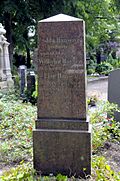
|
| Hilde Mangold | 1898-1924 | Biologist | Part I., field 2 | Location |
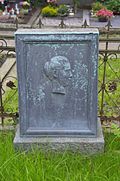
|
| Albin Nehrlich | 1845-1892 | Newspaper publisher ("Gothaisches Tageblatt") | Part II., Family place No. 287 / 287a | ||
| Albert Kandt | 1866-1926 | General director of the Gothaer Waggonfabrik | Part II., Right behind Querweg, Fam.-Pl. 617 | ||
| Paul Mattaei | 1851-1923 | Publishing bookseller | Part II., Left side of Querweg, Fam.-Pl. 209 | ||
| Heindrich Feldmann | 1863-1923 | Merchant | Part II., Left side of Querweg, Fam.-Pl. 214/216 | ||
| Otto Cyrus | 1859-1917 | Hofwagen manufacturer | Part II., Next to the memorial for those who fell in March, Fam.-Pl. 143 | ||
| Klaus Törpe | 1935-1950 | Cyclist | Part III., Box 11, 1c No. 69/70 | ||
| Karl Friedrich von Strenge | 1843-1907 | Legal scholar and Minister of State | Part II., Fam.-Pl. 612 |
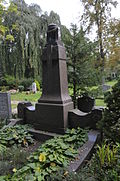
|
|
| Julius Cosmar | 1820-1899 | Landowners and benefactors | Freeman Grove | Location |

|
| Bertha Schneyer | 1830-1912 | Benefactress | Freeman Grove | Location |

|
| Hermann Robert Muller | 1845-1914 | Council of Churches, clergyman in the ducal state ministry, director of the orphan welfare institution | Freeman Grove | Location |

|
| Heinrich Kunreuther | 1864-1925 | Lawyer | Part I., box 23 | Location |
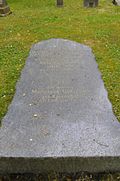
|
| Hermann habenicht | 1844-1917 | cartographer | Area for tombs worth preserving | Location |
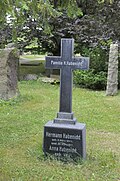
|
| Friedrich Jacobs | 1764-1847 | Classical philologist, numismatist and writer | Rondell tomb Lord Mayor | Location |

|
| Johann Ehrenfried Freund | 1834-1903 | Senator, patron of Gotha | Freeman Grove | Location |
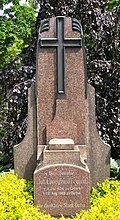
|
| Paul Friedrichs | 1859-1928 | Commerce councilor, brickworks owner | Fam.-Pl. 347 | Location |
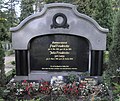
|
| Johannes Doebel | 1835-1908 | Honorary citizen, bank director, secret finance council (since 1891) and director of the Gotha fire insurance bank | Freeman Grove | Location |

|
| Otto Boehm | 1870-1928 | Merchant | Fam.-Pl. 622 | Location |

|
| Oskar stupid | 1853-1916 | Secret Commerce Councilor and Entrepreneur (rubber factory) | Freeman Grove | Location |

|
| Julius Bertuch | 1838-1904 | architect | Part I., box 32 | Location |

|
| Wilhelm Ewald | 1825-1888 | District Administrator | Family place 178 | Location |

|
| August Koehler | 1821-1879 | Pedagogue | Area for tombs worth preserving | Location |

|
| Hugo Mairich | 1863-1902 | engineer | Family place 489 | Location |

|
| Kurd Lasswitz | 1848-1910 | writer | Urnenplatz 119 | Location |

|
| Albert of Bamberg | 1844-1910 | Pedagogue | Grove of Honor | Location |

|
| Bertha von Suttner | 1843-1914 | Writer | Urn in the columbarium | Location |

|
| Arwed Emminghaus | 1831-1916 | Economist and honorary citizen of Gotha | Family place 596 | Location |

|
| Julius Krusewitz | 1850-1923 | architect | Family place 177 | Location |

|
| Robert Friedrichs | 1849-1924 | Entrepreneur | Part II., Field 12, family place 606/607 | ||
| August stupid | 1852-1927 | Entrepreneur | Part II., Field 12, family place 618 | ||
| Gottfried Moßler | 1844-1927 | Local politician and honorary citizen of Gotha | Part II., Field 13, urn place no. 2/3 | Location |

|
| Fritz Bothmann | 1858-1928 | Entrepreneur | Fam.-Pl. 294/295 | Location |

|
| Otto Liebetrau | 1855-1928 | Local politician, Lord Mayor and honorary citizen of Gotha | Honor roundel | Location |

|
| Wilhelm Bock | 1846-1931 | Trade unionists and politicians | Part II. Field 4a, corner | Location |

|
| Carl Rohrbach | 1861-1932 | Educator and astronomer | Family place 325 a | Location |

|
| Philipp Harjes | 1860-1933 | Entrepreneur, Privy Councilor of Commerce | Family place 603 | Location |

|
| Friedrich Burbach | 1866-1934 | Pastor at the Augustinian Church (1891–1933) | Part III., Field 4 Ib, No. 52 | Location (approx.) |

|
| Karl Kohlstock | 1864-1935 | Pedagogue | Part III., Field 4 IIb, No. 8 |

|
|
| Alfred Cramer | 1872-1938 | architect | Part II., Urnenplatz, Fam.-Platz No. 95 | ||
| Georg Florschütz | 1859-1940 | Mediciners | Ehrenhain, Fam.-Platz 417 | Location |

|
| Adolf Schmidt | 1860-1944 | Geophysicist | Columbarium | Location | |
| Ernst Anding | 1860-1945 | astronomer | Family place 224 | Location |

|
| Karl Samwer | 1861-1946 | Lawyer and constitutional lawyer, honorary citizen of Gotha | Family place No. 534 | Location |
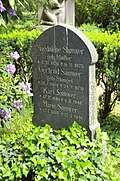
|
| Otto Geithner | 1876-1948 | Politician and journalist | Urnenplatz 205 a | Location |

|
| Paul Langhans | 1867-1952 | Geographer and cartographer | Fam.-Pl. 545 | Location |

|
| Richard new territory | 1884-1958 | architect | Part II., Field 17, Urnenplatz 1113/14 | ||
| Bruno Tamme | 1883-1964 | architect | Field 3 IIb, No. 97 | ||
| Hermann Haack | 1872-1966 | Cartographer and honorary citizen of Gotha | Family place 171/172 | Location |

|
| Kurt Kauter | 1913-2002 | writer | |||
| Hanns Cibulka | 1920-2004 | writer | Grove of Honor | Location |
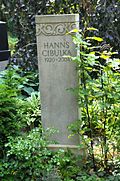
|
Area of exposed tombs
When the old Gotha cemeteries I to IV were cleared , a few grave monuments of important personalities were secured and placed in the main cemetery. The exposed tombs can be found on a green area to the right of the main path in front of the waiting hall. Here are the tombstones of:
| Surname | Life dates | job | original burial place | Coordin. | image |
|---|---|---|---|---|---|
| Peter Andreas Hansen | 1795-1874 | Astronomer and geodesist | Cemetery IV | Location |

|
| August Petermann | 1822-1878 | Geographer and cartographer | Cemetery IV | Location |

|
| Conrad Ekhof | 1720-1778 | Actor, co-founder of the first German court theater | Cemetery II | Location |

|
| Justus Perthes | 1749-1816 | Booksellers and publishers | Cemetery I. | Location |

|
| Ludwig Bohnstedt | 1822-1885 | architect | Cemetery IV | Location |

|
| Johann Ludwig Böhner | 1787-1860 | Composer, piano and organ virtuoso | Cemetery III |

|
|
| Wilhelm Pertsch | 1832-1899 | Librarian and Orientalist | Cemetery IV | Location |

|
At the back of the waiting hall, Andreas Reyher's tombstone from Cemetery I is set into the wall.
See also
- List of cemeteries in Gotha
- Pictures of tombs and tombs of the Gotha main cemetery on Wikimedia Commons
literature
- Bund Heimat und Umwelt in Deutschland: Historic cemeteries in Germany.
- Books.Google.de page 207
Web links
- Cemeteries on the website of the city of Gotha
Remarks
- ↑ Instead of “Neumark im Vogtland”, the stonemason's birthplace on the urn column incorrectly marked “Neumarkt im Vogtland”.
Individual evidence
- ↑ City Council (ed.): Commemorative publication for 50 years. Existence of the crematorium in Gotha , Gotha 1928, p. 16.
- ↑ a b Historical development of the Undertaker Guild of Saxony-Anhalt
- ↑ Gotha: With cremation against belief in resurrection deutschlandfunkkultur.de, January 4, 2015.
- ↑ a b Main cemetery Gotha cemetery flyer (PDF)
- ↑ Funding project crematorium in Gotha. German Foundation for Monument Protection , accessed on November 20, 2014 .
- ↑ Article by Prof. Dr. Norbert Fischer
Coordinates: 50 ° 57 ′ 56.2 " N , 10 ° 42 ′ 29.5" E




